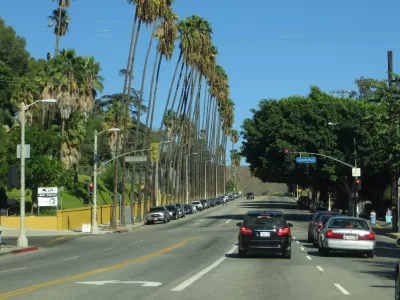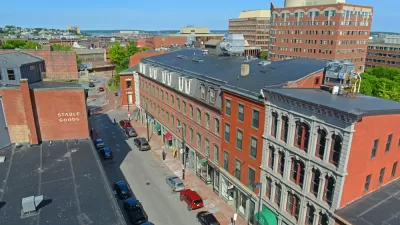The Green New Deal is far from the law of the land, but if this nation were to adopt the legislative agenda proposed by congressional Democrats, it would (and should) have major implications for planning practice.

[Updated February 12, 2019.]
As reported late last week by Planetizen correspondent Irvin Dawid, Sen. Edward J. Markey (D-Mass.) and Rep. Alexandria Ocasio-Cortez (D-N.Y.) introduced a nonbinding House resolution that has become commonly known as the Green New Deal, calling for the country to transition to carbon neutrality by 2030.
Since that release, and in the weeks leading up to the documents full reveal, commentators have been lining up to offer their take on the Green New Deal. Some of that analysis has focused on matters related to the work of planners.
Taking the Train to Green
Umair Irfan writes for Vox on the Green New Deal's focus on train travel—an agenda quickly ridiculed by Conservative commentators, but embraced by Irfain.
"For a big, ambitious plan to fight climate change, it would make perfect sense to target transit in general and air travel in particular," writes Irfain. Trains are already competing with airlines in many parts of the country and many more parts of the world, notes Irfain, and shifting from air travel to trains would drastically reduce carbon emissions from the transportation sector.
Land Use Missing in Action
A few weeks before the Green New Deal made it to the House floor, Jenny Schuetz provided analysis of the earliest outlines of the Green New Deal, focusing specifically on the land use measures included in the proposed agenda.
As noted by Schuetz, however, the Green New Deal does no address land use, despite "decades of poor urban land use decisions" being "a major underlying cause of environmental harm."
"Specifically, better urban land use would reduce greenhouse gas emissions (GHGs) from cars and limit the human and financial costs caused by developing environmentally risky land," writes Schuetz.
To better integrate land use planning and development into the Green New Deal, Schuetz recommends three broad policy goals: 1) improving the balance of jobs, housing, and services to reduce driving; 2) reducing development on environmentally risky land; and 3) improving governance and land use approval processes.
A 'Huge Flaw'
Finally, an article by Alex Baca exposes that lack of focus on issues of land use and development as the "huge flaw" of the Green New Deal. Here's Baca's strongly worded premise:
But the Green New Deal has a big blind spot: It doesn’t address the places Americans live. And our physical geography—where we sleep, work, shop, worship, and send our kids to play, and how we move between those places—is more foundational to a green, fair future than just about anything else. The proposal encapsulates the liberal delusion on climate change: that technology and spending can spare us the hard work of reform.
To make that point, Baca analyzes digs into the environmental and economic costs of sprawl, directly countering arguments that electric vehicles can save the planet from climate change if humans continue to sprawl across the planet.
Update: The Suburbs
After Planetizen published this summary of Green New Deal-related articles, Amanda Kolson Hurley added another entry to the record, this time about the potential of the Green New Deal to retrofit the suburbs. To do so, writes Hurley, the New Green Deal should look to the Old Deal, and the greenbelt-towns program, undertaken by the federal Resettlement Administration (RA) in Maryland, Ohio, and Wisconsin.
FULL STORY: The Green New Deal’s Huge Flaw

Maui's Vacation Rental Debate Turns Ugly
Verbal attacks, misinformation campaigns and fistfights plague a high-stakes debate to convert thousands of vacation rentals into long-term housing.

Planetizen Federal Action Tracker
A weekly monitor of how Trump’s orders and actions are impacting planners and planning in America.

In Urban Planning, AI Prompting Could be the New Design Thinking
Creativity has long been key to great urban design. What if we see AI as our new creative partner?

How Trump's HUD Budget Proposal Would Harm Homelessness Response
Experts say the change to the HUD budget would make it more difficult to identify people who are homeless and connect them with services, and to prevent homelessness.

The Vast Potential of the Right-of-Way
One writer argues that the space between two building faces is the most important element of the built environment.

Florida Seniors Face Rising Homelessness Risk
High housing costs are pushing more seniors, many of them on a fixed income, into homelessness.
Urban Design for Planners 1: Software Tools
This six-course series explores essential urban design concepts using open source software and equips planners with the tools they need to participate fully in the urban design process.
Planning for Universal Design
Learn the tools for implementing Universal Design in planning regulations.
Gallatin County Department of Planning & Community Development
Heyer Gruel & Associates PA
JM Goldson LLC
City of Camden Redevelopment Agency
City of Astoria
Transportation Research & Education Center (TREC) at Portland State University
Jefferson Parish Government
Camden Redevelopment Agency
City of Claremont





























